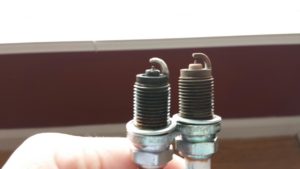What motorists need to know is that spark plugs do NOT last forever, even the long-life 100,000 mile plugs. All spark plugs need to be changed sooner or later. Here’s why:
- New plugs maintain peak engine performance and efficiency. Every engine will misfire occasionally. But as the number of misfires per mile goes up over time, it increases exhaust emissions, wastes gas and reduces power. In the past, most motorist would not notice the gradual decline in ignition performance until it reached a point where it created a steady miss, caused the engine to run rough, buck or stall, or made it hard to start. Not so today. All 1996 and newer vehicles have an OBD II onboard diagnostic system that tracks ignition misfires. When the rate of misfires exceeds a certain limit and causes emissions to increase 50% over baseline levels, it illuminates a warning light. Too bad older vehicle do not have this watchdog system. So on older vehicles, replacing the spark plugs at the recommended service intervals for preventive maintenance will reduce the risk of misfires and maintain peak engine performance. For standard spark plugs, the service interval is typically every 45,000 miles. For platinum spark plugs, it is 100,000 miles.
A new set of plugs is not a cure-all for driveability and emissions problems, but in many cases a plug change can make a significant improvement. Changing the plugs can reduce hydrocarbon (HC) emissions up to several hundred parts per million, which may make the difference between failing and passing an emissions test.
- New plugs improve cold starting. Bad plugs are often responsible for many cold weather “no start” service calls. Many times the battery has been run dead while cranking the engine because the plugs would not light the fire. When the old plugs are removed and examined, they are often found to be worn or dirty. Dirty spark plugs can cause fouling which results in misfiring.
New plugs reduce the voltage requirements on the ignition system, which decreases the chance of misfire while leaving more amps for the starter and injectors.
Wet fouled plugs can also prevent an engine from starting, but in many instances the fouling problem has nothing to do with plug wear or neglect. If an engine is flooded with fuel while it is being cranked, gasoline can soak the plugs and bleed off the ignition voltage before it forms a spark. Wet fouling tends to be more common on older vehicles that have carburetors because pumping the gas pedal can easily flood the engine with too much fuel. Flooding can also occur if the choke sticks, the float is set too high or the needle valve leaks. On fuel injected engines, wet fouling is less of a problem but can happen if a cold start injector leaks or there is a fuel calibration problem that creates an overly rich startup mixture. The cure in all cases is to wait for the plugs to dry out, or to remove the plugs and clean or replace them.
- New plugs minimize the risk ofcatalytic converter A single misfiring plug can dump enough raw fuel into the exhaust to overheat and damage the converter. The presence of higher than normal quantities of unburned gasoline in the exhaust will cause the operating temperature of the converter to soar, which may lead to a partial of complete meltdown of the converter substrate. This, in turn, may form a partial restriction or complete blockage in the exhaust that creates enormous backpressure and chokes off the engines ability to exhale. The engine may lack power, especially at higher speeds, and deliver terrible fuel economy. Or, it may stall and refuse to run after it is first started. Replacing the converter will solve the restriction problem. But unless the spark plugs are replaced, the new converter may soon die from the same ailment.
Source: aa1car

